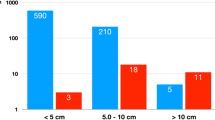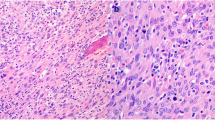Summary
The monoclonal antibody D11 is a valuable aid in the accurate typing of adrenal tumours as, in formalin-fixed, paraffin-embedding material, strong nuclear D11 positivity was observed only in adrenocortical cells in 190 neoplasms (including 100 adrenal tumours). This pattern was demonstrated for all zona glomerulosa cells in 27 normal adrenals and for the neoplastic cells of 15 adrenocortical adenomas derived from that zone, as judged from clinically evident hyperaldosteronism. Normal cells of zona fasciculata and reticularis also showed strong diffuse D11 immunostaining and the same nuclear plus cytoplasmic D11 reactivity was evident in 15 benign and malignant adrenocortical neoplasms derived from these zones, documented by hypercortisolism. Cytoplasmic and/or nuclear D11 staining made topohistogenetic typing possible in 15 non-functioning cortical tumours. D11 immunostaining gave negative results in 50 specimens containing normal, hyperplastic and neoplastic adrenomedullary cells. In addition, absence of D11 reactivity was recorded in 4 adrenal metastases of extra-adrenal carcinomas, 5 paragangliomas, 25 primary renal carcinomas and 59 of 60 primary thyroid carcinomas. D11 immunocytochemistry allows the accurate typing of benign and malignant adrenocortical neoplasms, irrespective of histology and function. With this method, primary adrenocortical tumours can be separated from carcinomas metastatic to the adrenal gland, including secondary tumours of similar phenotype (such as renal carcinomas). By exclusion, D11 negativity provides evidence of the medullary origin of primary adrenal tumours even in the absence of clinical, structural, histochemical and conventional immunohistochemical indicators of phaeochromocytoma.
Similar content being viewed by others
References
Beisiegel U, Kita T, Anderson RGW, Schneider WJ, Brown MS, Goldstein JL (1981) Immunologic cross-reactivity of the low density lipoprotein receptor from bovine adrenal cortex, human fibroblasts, canine liver and adrenal gland, and rat liver. J Biol Chem 1256:4071–4078
Beisiegel U, Weber W, Havinga JR, Ihrke G, Hui DY, Wernette-Hammond ME, Turck CW, Innerarity TL, Mahley RW (1988) Apolipoprotein E-binding proteins isolated from dog and human liver. Arteriosclerosis 8:288–297
Dhom G (1981) Die Nebennierenrinde. In: Doerr W, Seifert G, Uehlinger E (eds) Spezielle pathologische Anatomie, vol 14/ii. Pathologie der endokrinen Organe II. Springer, Berlin Heidelberg New York, pp 729–970
Dietel M, Arps H, Gerding D, Trapp M, Niendorf A (1987) Establishment of primary cell cultures: experiences with 155 cell strains. Klin Wochenschr 65:507–512
Dralle H, Schröder S, Gratz KF, Grote R, Padberg B, Hesch RD (1990) Sporadic unilateral adrenomedullary hyperplasia with hypertension cured by adrenalectomy. World J Surg (in press)
Geuze HJ, Slot JW, Yanagibashi K, McCracken JA, Schwartz AL, Hall PF (1987) Immunogold cytochemistry of cytochromes P-450 in porcine adrenal cortex. Two enzymes (side-chain cleavage and 11 beta-hydroxylase) are co-localized in the same mitochondria. Histochemistry 86:551–557
Grimelius L, Wilander E (1984) Silver impregnation and other non-immunocytochemical staining methods. In: Polak JM, Bloom SR (eds) Endocrine tumours: the pathobiology of regulatory peptide-containing tumours. Churchill-Livingstone, Edinburgh, pp 95–115
Hacker GW, Bishop AE, Terenghi G, Varndell IM, Aghahowa J, Pollard K, Thurner J, Polak JM (1988) Multiple peptide production and presence of general neuroendocrine markers detected in 12 cases of human phaeochromocytoma and in mammalian adrenal glands. Virchows Arch [A] 412:399–411
Hamid Q, Varndell IM, Ibrahim NB, Mingazzini P, Polak JM (1987) Extraadrenal paragangliomas. An immunocytochemical and ultrastructural report. Cancer 60:1776–1781
Heitz PU (1987) Neuroendocrine tumor markers. In: Seifert G (ed) Morphological tumor markers. Springer, Berlin Heidelberg New York, pp 279–306
Hsu SM, Raine L, Fanger H (1981) Use of avidin-biotin-peroxidase complex (ABC) in immunoperoxidase techniques: a comparison between ABC and unlabeled antibody (PAP) procedures. J Histochem Cytochem 29:577–580
Hui DY, Brecht WJ, Hall EA, Friedman G, Innerarity TL, Mahley RW (1986) Isolation and characterization of the apolipoprotein E receptor from canine and human liver. J Biol Chem 261:4256–4267
Kaetzel CS, Rao CK, Lamm ME (1987) Protein disulphide-isomerase from human placental and rat liver. Purification and immunological characterization with monoclonal antibodies. Biochem J 241:39–47
Kimura N, Sasano N, Yamada R, Satoh J (1988) Immunohistochemical study of chromogranin in 100 cases of pheochromocytoma, carotid body tumour, medullary thryoid carcinoma and carcinoid tumour. Virchows Arch [A] 413:33–38
Krause M, Reinhardt D, Kruse K (1988) Phaeochromocytoma without symptoms: desensitization of theα- andΒ-adrenoceptors. Eur J Pediatr 147:121–122
Mackay AM (1969) Atlas of human adrenal cortex ultrastructure. In: Symington T (ed) Functional pathology of the human adrenal gland, part IV. Williams and Wilkins, Baltimore, pp 346–489
Mitschke H, Saeger W, Breustedt JJ (1973) Zur Ultrastruktur der Nebennierenrindentumoren beim Cushing-Syndrom. Virchows Arch [A] 360:253–264
Myllylä R, Koivu J, Pihlajaniemi T, Kivirikko KI (1983) Protein disulphide-isomerase activity in various cells synthesizing collagen. Eur J Biochem 134:7–11
Neville DM (1971) Molecular weight determination of protein-dodecyl sulfate complexes by gel electrophoresis in a discontinuous buffer system. J Biol Chem 246:6328–6334
Page DL, DeLellis RA, Hough AJ (1986) Tumors of the adrenal. Atlas of tumor pathology, 2nd series, fascicle 23. Armed Forces Institute of Pathology, Washington, DC
Plouin PF, Chatellier G, Delahousse M, Rougeot MA, Duclos JM, Pagny JY, Corvol P, Ménard J (1987) Recherche, diagnostic et localisation du phéochromocytome. 77 case dans une population de 21 420 hypertendus. Presse Med 16:2211–2215
Probst A (1965) Elektronenmikroskopie der Nebennierenrinde bei primärem Aldosteronismus. Beitr Pathol Anat 131:1–21
Ramsay JA, Asa SL, Nostrand AWP van, Hassaram ST, Harven EP de (1987) Lipid degeneration in pheochromocytomas mimicking adrenal cortical tumors. Am J Surg Pathol 11:480–486
Samaan NA, Hickey RC (1987a) Pheochromocytoma. Semin Oncol 14:297–305
Samaan NA, Hickey RC (1978b) Adrenal cortical carcinoma. Semin Oncol 14:292–296
Sasano H, Okamoto M, Sasano N (1988a) Immunohistochemical study of cytochrome P-450 11Β-hydroxylase in human adrenal cortex with mineralo- and glucocorticoid excess. Virchows Arch [A] 413:313–318
Sasano H, White PC, New MI, Sasano N (1988b) Immunohistochemical localization of cytochrome P-450 C21 in human adrenal cortex and its relation to endocrine function. Hum Pathol 19:181–185
Schröder S, Niendorf A, Dietel M, Beisiegel U (1989) Immunocytochemical differential diagnosis of adrenocortical neoplasm through new monoclonal antibody D11 (A 1193). Proc Am Assoc Cancer Res 30:300
Scott HW, Reynolds V, Green N, Page D, Oates JA, Robertson D (1982) Clinical experience with malignant pheochromocytomas. Surg Gynecol Obstet 154:801–818
Shapiro B, Sisson JC, Lloyd R, Nakajo M, Satterlee W, Beierwaltes WH (1984) Malignant pheochromocytoma: clinical, biochemical and scinigraphic characterization. Clin Endocrinol 20:189–203
Sommers SC, Terzakis JA (1970) Ultrastructural study of aldosterone-secreting cells of the adrenal cortex. Am J Clin Pathol 54:303–308
Author information
Authors and Affiliations
Additional information
Dedicated to Prof. Dr. Dr. h.c. mult. Wilhelm Doerr on the occasion of his 75th birthday. This study has been sponsored by the Deutsche Forschungsgemeinschaft and the Hamburger Krebsgesellschaft and was presented in part at the 80th Annual Meeting of the American Association for Cancer Research, San Francisco, California, 24–27 May 1989 (Schröder et al. 1989)
Rights and permissions
About this article
Cite this article
Schröder, S., Mendorf, A., Achilles, E. et al. Immunocytochemical differential diagnosis of adrenocortical neoplasms using the monoclonal antibody D11. Vichows Archiv A Pathol Anat 417, 89–96 (1990). https://doi.org/10.1007/BF02190525
Received:
Revised:
Accepted:
Issue Date:
DOI: https://doi.org/10.1007/BF02190525




